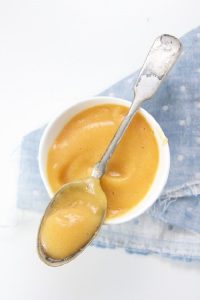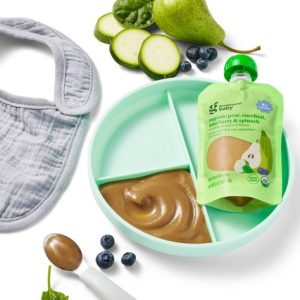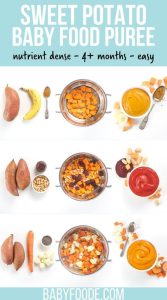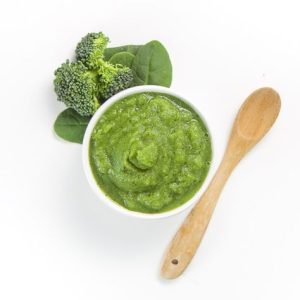Welcome to the exciting world of feeding your 6-month-old baby! Around this age, many babies are ready to start exploring solid foods alongside breast milk or formula. Vegetable puree for 6 month baby
is a fantastic first food for many babies. They are packed with nutrients and can be a gentle introduction to new flavors and textures.
This article explores the delicious world of vegetable purees for your 6-month-old baby. We will cover the benefits of vegetable purees, how to choose and make them, and tips for serving them to your little one.
Important Note: Always consult your pediatrician before introducing solid foods to your baby. They can advise you on the best time to start and which foods to introduce first.
The Goodness of Vegetable Purees for Babies
Vegetable purees offer a variety of benefits for your 6-month-old baby’s growth and development:
Essential Nutrients:
Vegetables are packed with essential vitamins, minerals, and fiber, all important for your baby’s healthy development.
Flavor Adventure:
Vegetable purees introduce your baby to a world of new flavors, helping them develop a taste for healthy foods.
Texture Practice:
Purees help your baby learn to swallow and manipulate food in their mouth, which is a stepping stone to eating more solid foods later.

Selecting Vegetables for Vegetable Puree for 6 month Baby
When choosing vegetables for your 6-month-old’s purees, consider these factors:
-
Sweetness: Babies often prefer sweet flavors. Start with naturally sweet vegetables like carrots, sweet potatoes, and peas.
-
Mild Flavor: Choose vegetables with a mild flavor that won’t overwhelm your baby’s delicate palate.
-
Ripeness: Select ripe vegetables for the sweetest flavor and the best texture.
Homemade or Store-Bought Purees?
You can choose to make your own vegetable purees at home or purchase them pre-made from the store. Here’s a breakdown of the pros and cons of each option:
-
Homemade Purees:
-
Pros: You control the ingredients and can ensure they are organic and free of added sugar or salt.
-
Cons: Making purees takes time and planning.
-
-
Store-bought Purees:
-
Pros: Convenient and readily available.
-
Cons: May contain added sugar or salt. Check the label carefully.
-

Creating Delicious Vegetable Purees at Home
Here are some simple steps to follow for making delicious homemade vegetable purees for your 6-month-old baby:
-
Wash and Steam Vegetables: Wash and steam your chosen vegetables until tender. Steaming helps preserve nutrients.
-
Puree the Vegetables: Use a blender, food processor, or immersion blender to puree the steamed vegetables until smooth.
-
Adjust Consistency: Add a little water or breast milk to the puree to achieve a consistency that is easy for your baby to swallow.
-
Serve Immediately: Freshly made purees are best. You can store leftover puree in the refrigerator for up to 2 days or freeze it for longer storage.
Introducing Vegetable Puree for 6 month baby
Here are some tips for introducing vegetable purees to your 6-month-old baby in a positive way:
-
Start with Single Vegetables: Introduce new vegetables one at a time to identify any allergies.
-
Tiny Portions: Begin with just a spoonful or two of puree at first.
-
Room Temperature: Serve the puree at room temperature.
-
Let Your Baby Take the Lead: Place a small amount of puree on a spoon and allow your baby to self-feed. This encourages exploration and reduces the risk of overfeeding.
-
Be Patient: It may take your baby a few tries to get used to the taste and texture of purees. Be patient and encouraging.

Adding Variety to Your Baby’s Purees
Once your baby is comfortable with single-vegetable purees, you can start to explore flavor combinations:
-
Mix and Match: Combine different vegetables to create new flavor combinations. For example, try sweet potato and carrot puree or peas and avocado puree.
-
Herbs and Spices (a Tiny Pinch): You can add a tiny amount of dried herbs or spices like thyme or cinnamon to introduce your baby to new flavors.
-
Fruits (Once Approved by Pediatrician): Once your pediatrician approves, you can start to introduce fruits. Combine fruits and vegetables for a sweet and nutritious puree.
Introducing your 6-month-old baby to solid foods is a fun and rewarding experience. Vegetable purees are a great way to kickstart this exciting adventure. By following these tips and using your creativity, you can create delicious dishes.
Beyond the Purees: Exploring Textures Safely
As your 6-month-old gets accustomed to smooth purees, you can gradually introduce them to different textures, but safety is key! Here’s how to progress safely:
-
Thicker Purees: Gradually thicken the consistency of your purees by adding less water or breast milk.
-
Mashed Vegetables: Once your baby tolerates thicker purees, you can mash cooked vegetables instead of pureeing them completely. This will leave some small lumps that help your baby develop their chewing skills. However, make sure the mashed vegetables are still soft enough to easily mush between your fingers.
-
Soft Finger Foods: Around 8-10 months, you can introduce soft finger foods like steamed broccoli florets, ripe banana slices, or avocado wedges. Always supervise your baby closely during feeding and watch out for choking hazards.

Safety Tips for Feeding Your Baby
Here are some safety tips to remember when feeding your baby purees and other solid foods:
-
Always supervise your baby during mealtimes.
-
Cut food into small, age-appropriate pieces to prevent choking. For a 6-month-old, this means pieces no bigger than the size of a pea.
-
Do not force your baby to eat. Let them self-feed as much as possible.
-
Be aware of common allergens. Introduce new foods one at a time and watch for any allergic reactions.
-
Honey is not safe for babies under 1 year old.

Conclusion: A Journey of Discovery with Your Pediatrician
Introducing your baby to solid foods is a journey of discovery for both of you. Vegetable purees are a fantastic first step on this exciting path. By following these tips and creating a positive mealtime experience, you can help your baby develop a healthy relationship with food.
Remember: The most important thing is to be patient, observe your baby’s cues, and make mealtimes a fun and enjoyable experience. Always consult your pediatrician throughout this process. They are a valuable resource for all your baby’s health needs, including nutrition.
